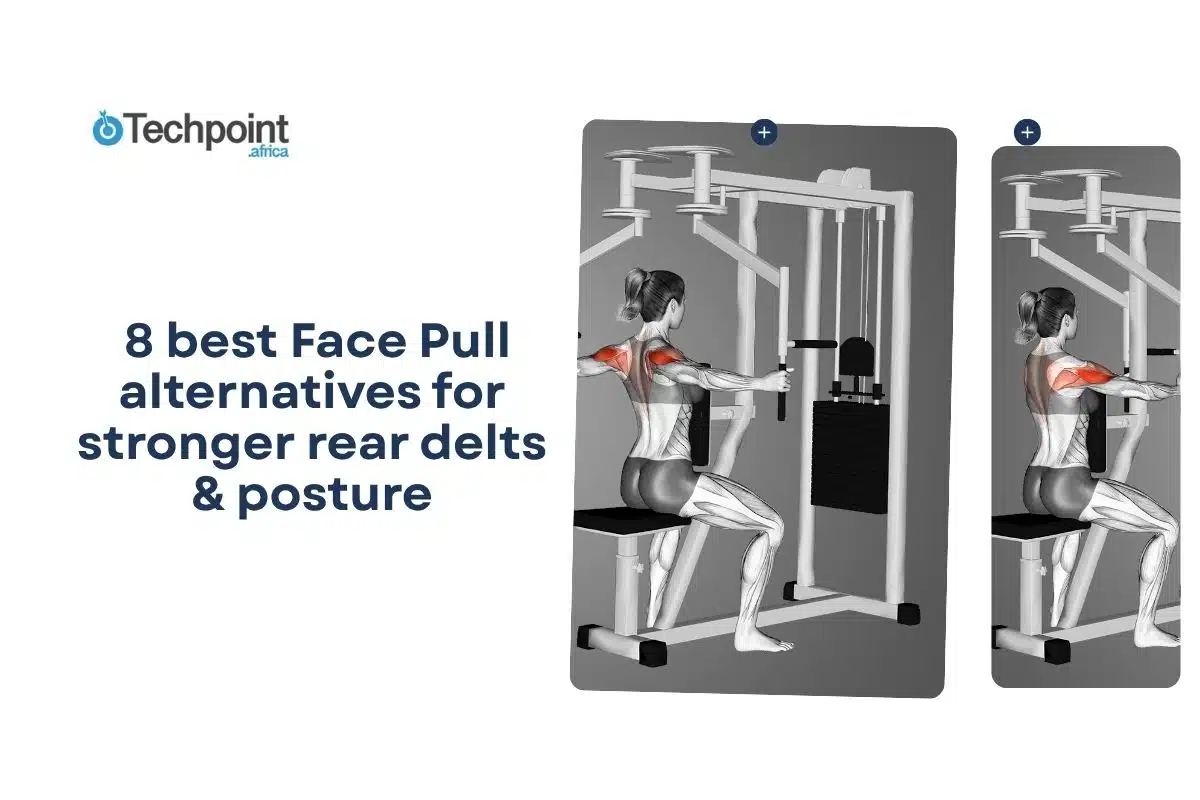Strong rear delts aren’t just about looking good—they’re essential for shoulder stability, preventing injuries, and improving posture. While face pulls are a popular choice, they aren’t the only way to strengthen this often-overlooked muscle group. If you want variety, better gains, or options for home and gym workouts, the exercises below will help you build stronger rear delts and maintain upright, healthy posture.
In this guide, you will learn:
- The top 8 alternatives to face pulls for rear delts and posture.
- How each exercise targets different parts of your upper back and shoulders.
- Tips to maintain proper form and avoid injuries.
- Which exercises are ideal for your fitness level and the equipment available?
8 face pull alternatives
- Reverse Pec Deck Fly
- Band Pull-Aparts
- Dumbbell Rear Delt Fly
- Cable Rear Delt Row
- Incline Bench Rear Delt Fly
- T-Raises
- Seated Bent-Over Dumbbell Lateral Raise
- TRX Rear Delt Rows
Comparison table
| Rank | Exercise | Description | Pros / Cons | Best For | Equipment / Cost |
| 1 | Reverse Pec Deck Fly | Machine-based rear delt fly | Pro: Isolates rear delts, easy to maintain form / Con: Requires gym machine | Gym-goers, beginners | Gym machine |
| 2 | Band Pull-Aparts | Pulling a resistance band apart to engage the rear delts | Pro: Portable, joint-friendly / Con: Hard to progressively overload | Beginners & home workouts | Resistance band, low cost |
| 3 | Dumbbell Rear Delt Fly | Bend-over dumbbell raises to shoulder height | Pro: Works rear delts and traps / Con: Requires dumbbells, form matters | Gym or home with dumbbells | Dumbbells |
| 4 | Cable Rear Delt Row | Cable machine row with elbows flared | Pro: Constant tension, adjustable weight / Con: Needs cable machine | Gym-goers | Cable machine |
| 5 | Incline Bench Rear Delt Fly | Lying on an incline bench, lifting dumbbells laterally | Pro: Stabilises core, isolates rear delts / Con: Requires bench and dumbbells | Home or gym | Incline bench + dumbbells |
| 6 | T-Raises | Lying face down or standing, lift arms to form “T” | Pro: Improves posture, minimal equipment / Con: Low resistance unless weighted | Beginners & posture work | Dumbbells optional |
| 7 | Seated Bent-Over Dumbbell Lateral Raise | Seated, leaning forward, lift dumbbells sideways | Pro: Prevents swinging, isolates rear delts / Con: Requires concentration | Home or gym | Dumbbells |
| 8 | TRX Rear Delt Rows | Suspension trainer row with elbows flared | Pro: Full-body engagement, adjustable difficulty / Con: Needs TRX or suspension straps | Home or gym | TRX / suspension straps |
Reverse Pec Deck Fly
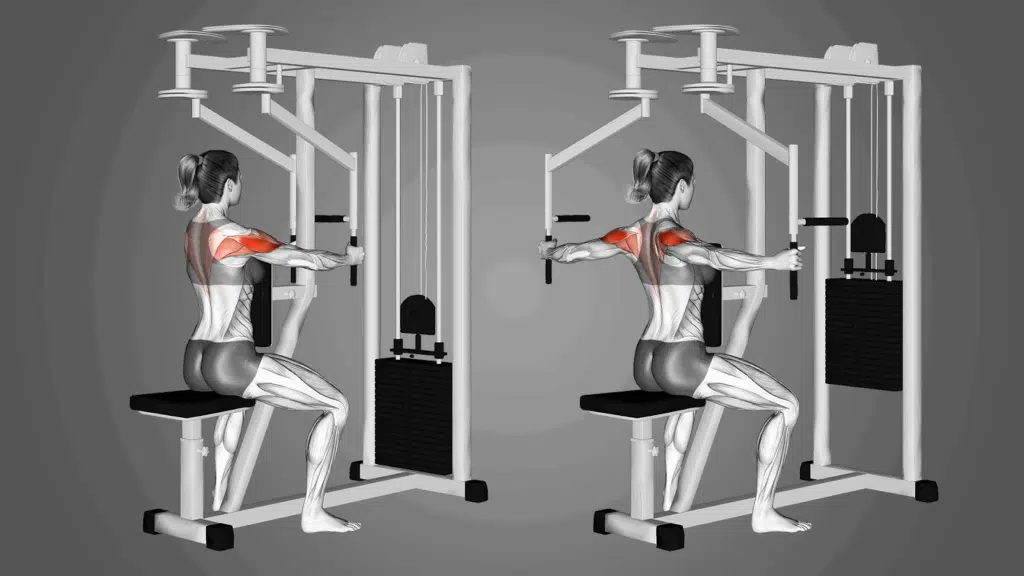
The Reverse Pec Deck Fly is a machine-based exercise that isolates your rear delts while engaging the upper traps and rhomboids. It’s ideal for beginners who want to focus on form without worrying about balancing weights, as the machine guides the user through the motion. This exercise strengthens the muscles that pull your shoulders back, making it excellent for improving posture and preventing rounded shoulders.
How to perform it:
- Sit on the pec deck machine facing the pads, with your chest against the pad and feet flat on the floor.
- Grab the handles or place your forearms against the pads, depending on the type of machine.
- With elbows slightly bent, pull your arms outward and back in a reverse fly motion until your elbows are roughly in line with your shoulders.
- Squeeze your shoulder blades together at the peak of the movement.
- Slowly return to the starting position to maintain tension throughout the exercise.
Pros:
- Easy to maintain proper form, reducing the risk of injury.
- Effectively isolates the rear delts, ensuring targeted growth.
- The adjustable weight allows for progressive overload, facilitating strength gains.
Cons:
- Limited to gym settings with a pec deck machine.
- Doesn’t engage stabilizing muscles as much as free weights or bands.
Tips:
- Focus on slow, controlled movements to fully engage the rear delts.
- Avoid shrugging your shoulders—keep the motion driven by the rear delts, not the traps.
- Adjust the seat so your shoulders align with the machine’s pivot point for optimal biomechanics.
Band pull-aparts
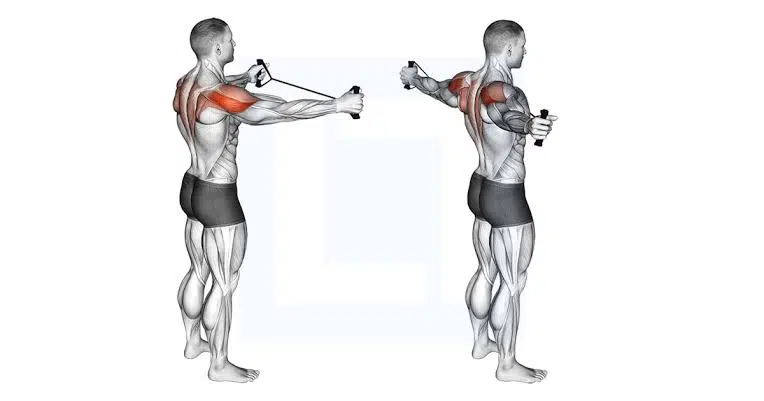
Band Pull-Aparts are a simple yet highly effective exercise for targeting the rear delts, rhomboids, and traps. They’re particularly popular for home workouts or as a warm-up to activate the posterior chain. This exercise improves posture by counteracting the forward pull of chest-dominant movements, making it particularly beneficial for individuals who spend long hours at a desk.
How to perform it:
- Stand tall with feet shoulder-width apart, holding a resistance band at shoulder height with both hands, palms facing down.
- Keep your arms straight but not locked, and pull the band apart by moving your hands outward.
- Focus on squeezing your shoulder blades together as you stretch the band.
- Slowly return to the starting position, maintaining tension in the band throughout the movement.
Pros:
- Extremely portable; can be done anywhere.
- Gentle on the joints, suitable for beginners and rehabilitation work.
- Activates stabilising muscles along with the rear delts.
Cons:
- Limited ability to progressively overload compared to free weights or machines.
- It can be too easy if using a light band; heavier resistance may be required for strength gains.
Tips:
- Keep your core engaged and avoid leaning back.
- Focus on slow, controlled movements rather than speed.
- Gradually increase resistance or reps to maintain progression.
Dumbbell rear delt fly
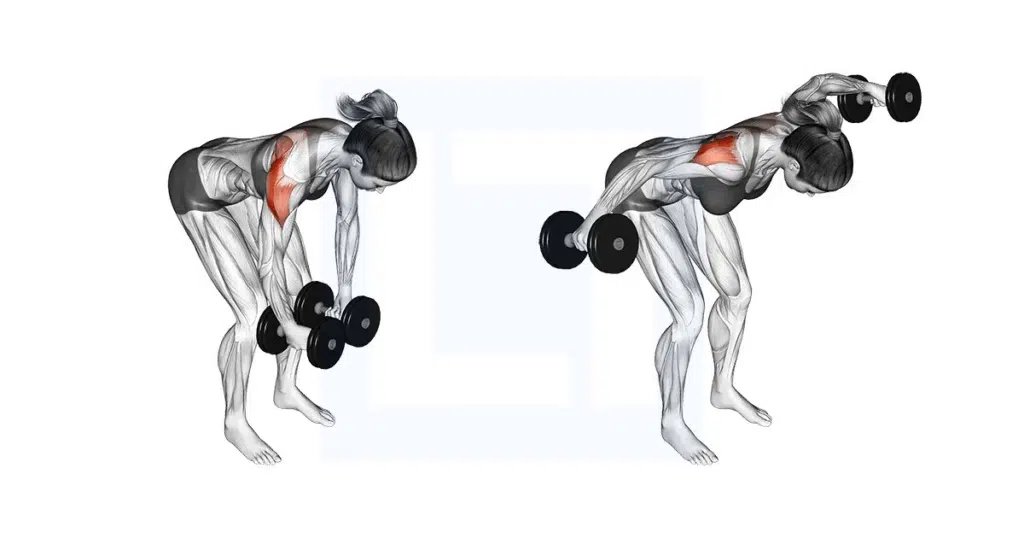
The Dumbbell Rear Delt Fly is a classic free-weight exercise that effectively isolates the rear delts while also engaging the traps and rhomboids. Unlike machine-based movements, it requires more stabilisation, which strengthens supporting muscles and improves shoulder balance. It’s ideal for both home and gym workouts, making it highly versatile.
How to perform it:
- Hold a dumbbell in each hand and bend forward at the hips until your torso is nearly parallel to the floor. Keep a slight bend in your knees.
- Let your arms hang straight down, palms facing each other.
- With elbows slightly bent, lift the dumbbells outward to form a “T” shape, squeezing your shoulder blades together at the top.
- Slowly lower the weights back to the starting position, maintaining control throughout the movement.
Pros:
- Strong isolation for rear delts and upper back muscles.
- Improves posture and shoulder stability.
- No machines required; can be done at home or in the gym.
Cons:
- Requires proper form to avoid swinging or straining the lower back.
- Moderate weights may limit progressive overload without heavier dumbbells.
Tips:
- Keep your torso stable and avoid momentum.
- Focus on slow, controlled lifts to fully engage the rear delts.
- Exhale at the top of the movement and inhale while lowering.
Cable Rear Delt Row
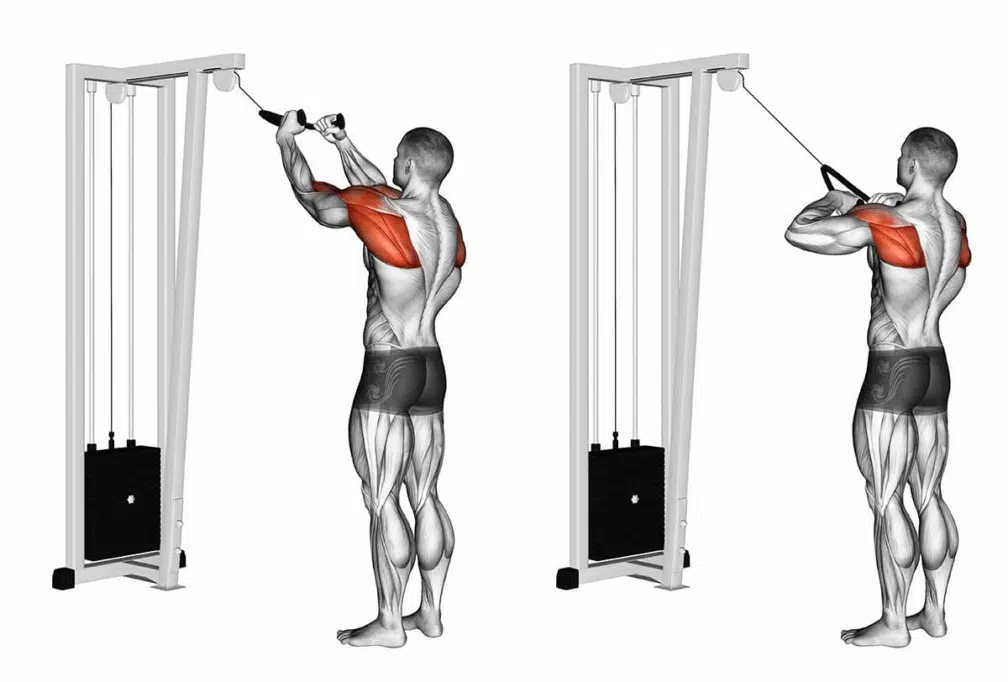
The Cable Rear Delt Row is a versatile exercise that targets the rear delts, traps, and rhomboids while providing constant tension throughout the movement. Unlike free weights, the cable ensures resistance at all points of the range of motion, which can enhance muscle activation and growth. This exercise is particularly effective for correcting rounded shoulders and improving upper-back posture.
How to perform it:
- Set a cable machine at chest height with a rope attachment.
- Grab the rope with an overhand grip and step back to create tension, feet shoulder-width apart.
- Hinge slightly at your hips while keeping your chest up and core engaged.
- Pull the rope toward your upper chest, flaring your elbows out to the sides. Focus on squeezing your shoulder blades together at the peak.
- Slowly return to the starting position, maintaining tension in the cable throughout the movement.
Pros:
- Constant resistance maximises muscle engagement.
- Adjustable weight allows for progressive overload.
- Supports good posture and shoulder stability.
Cons:
- Requires access to a cable machine.
- Beginners may struggle with elbow positioning and shoulder activation.
Tips:
- Keep movements controlled—avoid jerking the weight.
- Focus on pulling with your rear delts, not your arms.
- Start with a lighter weight to perfect form before increasing load.
Incline Bench Rear Delt Fly
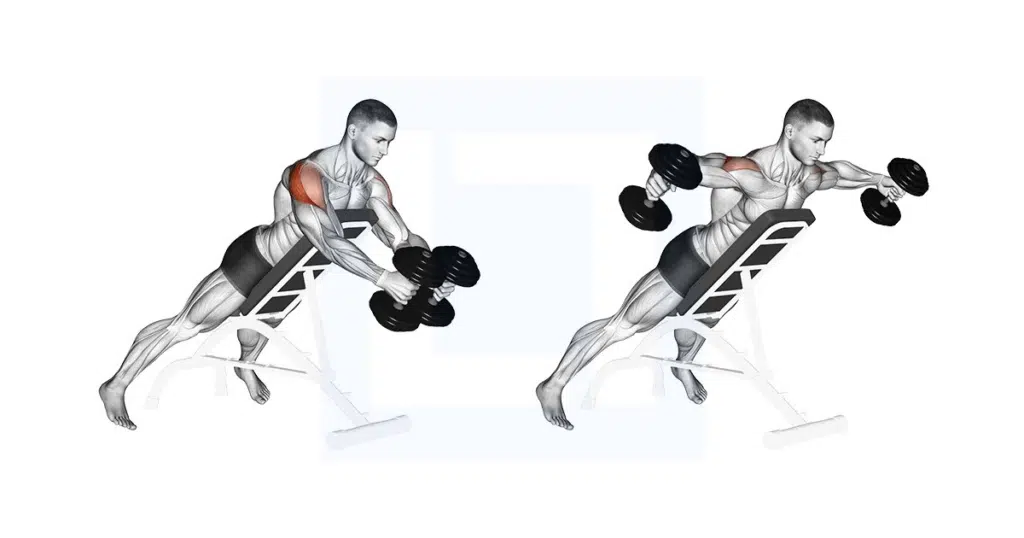
The Incline Bench Rear Delt Fly is a highly effective exercise for isolating the rear delts while minimising momentum and strain on the lower back. By lying face down on an incline bench, you stabilise your torso, allowing for a more focused contraction of the posterior shoulder muscles. This exercise also engages the traps and rhomboids, improving posture and shoulder health.
How to perform it:
- Set an incline bench to about 30–45 degrees and lie face down, holding a dumbbell in each hand with palms facing each other.
- Let your arms hang straight down toward the floor.
- With a slight bend in your elbows, lift the dumbbells out to the sides until your elbows are at shoulder height, squeezing your shoulder blades together at the top.
- Slowly lower the dumbbells back to the starting position, maintaining tension in the rear delts.
Pros:
- A stabilised torso prevents lower back strain.
- Isolates rear delts for maximal engagement.
- It can be performed at home or in the gym with minimal equipment.
Cons:
- Requires an incline bench and dumbbells.
- Heavier weights may compromise form if not controlled properly.
Tips:
- Keep movements slow and controlled for better muscle activation.
- Avoid shrugging your shoulders—focus on rear delt engagement.
- Exhale while lifting, inhale while lowering.
T-Raises
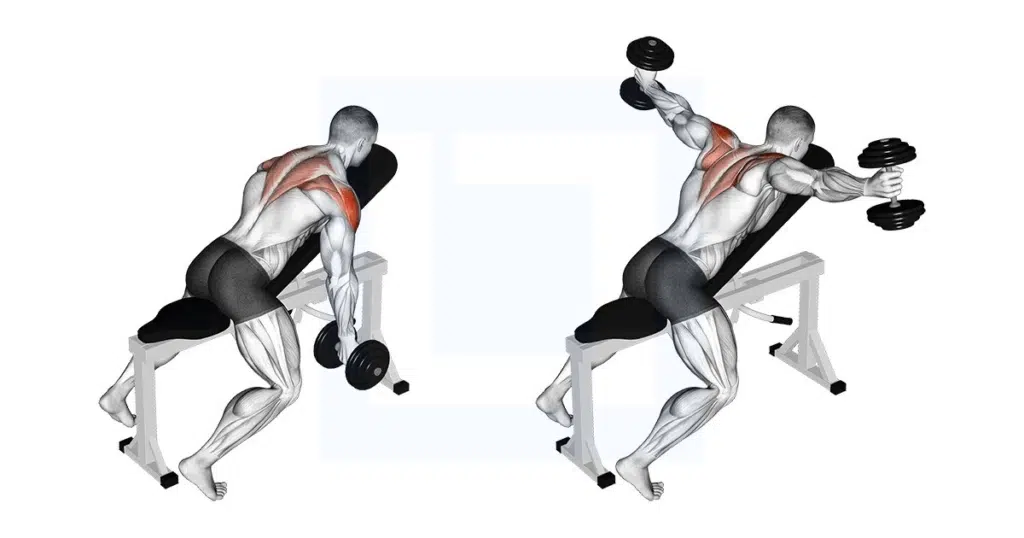
T-Raises are a simple yet highly effective exercise for strengthening the rear delts, traps, and rhomboids, making them ideal for posture correction. They can be performed lying face down on a bench, prone on the floor, or even standing while leaning slightly forward. T-Raises are particularly useful for beginners and those looking for low-impact shoulder work.
How to perform it:
- Hold a light dumbbell in each hand (or no weight for beginners) and either lie face down on a bench or hinge forward at the hips while standing.
- Let your arms hang straight down, palms facing each other.
- With a slight bend in your elbows, raise your arms out to the sides until they are level with your shoulders, forming a “T” shape.
- Squeeze your shoulder blades together at the top and slowly lower your arms back down with control.
Pros:
- Minimal equipment needed; can be done at home or gym.
- Improves posture and shoulder stability.
- Low-impact, making it safe for beginners and rehab work.
Cons:
- Limited progressive overload without added weights.
- It may feel too easy for advanced lifters unless resistance is increased.
Tips:
- Focus on slow, controlled movements to maximize rear delt engagement.
- Keep your torso stable and avoid swinging your arms.
- Gradually increase weight or reps to continue challenging your muscles.
Seated bent-over dumbbell lateral raise
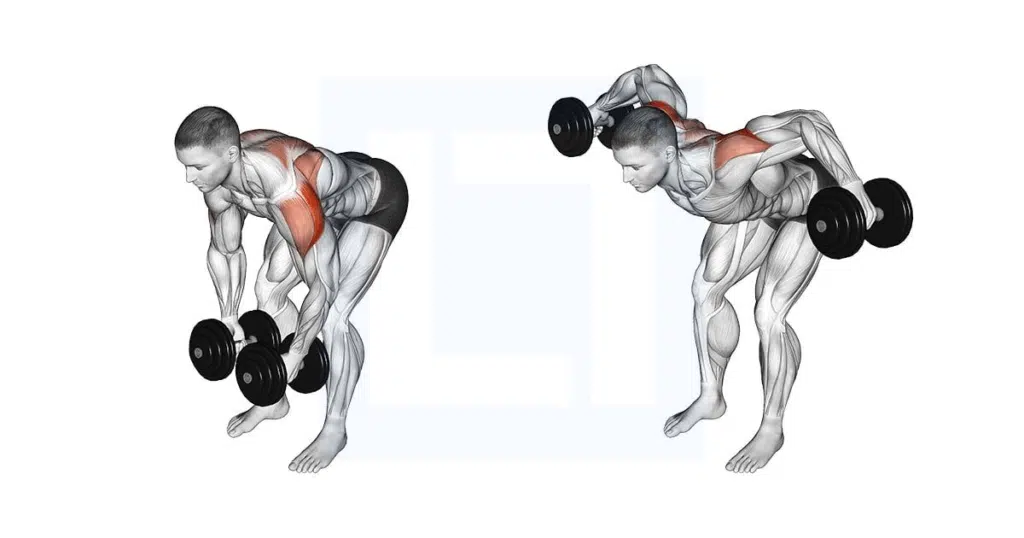
The Seated Bent-Over Dumbbell Lateral Raise is a highly effective rear delt isolation exercise that reduces momentum by keeping your torso stable. By performing this movement seated, you eliminate swinging from the lower body, ensuring maximum engagement of the posterior delts and upper back muscles. This makes it excellent for improving posture, shoulder stability, and rear delt definition.
How to perform it:
- Sit on the edge of a bench with your feet flat on the floor, holding a dumbbell in each hand.
- Hinge forward at the hips, so your torso leans slightly forward, keeping your back straight.
- Let your arms hang down naturally with palms facing each other.
- With a slight bend in your elbows, lift the dumbbells out to the sides until your elbows reach shoulder height, squeezing your shoulder blades together at the top.
- Slowly lower the dumbbells back to the starting position with control.
Pros:
- Strong isolation of rear delts and upper back muscles.
- Seated position minimises momentum, improving form.
- It can be done at home or in the gym with dumbbells.
Cons:
- Limited load if only using light dumbbells.
- Requires focus to avoid shrugging or swinging arms.
Tips:
- Keep movements slow and controlled for maximum activation.
- Focus on squeezing the shoulder blades at the peak.
- Exhale while lifting and inhale while lowering.
TRX Rear Delt Rows
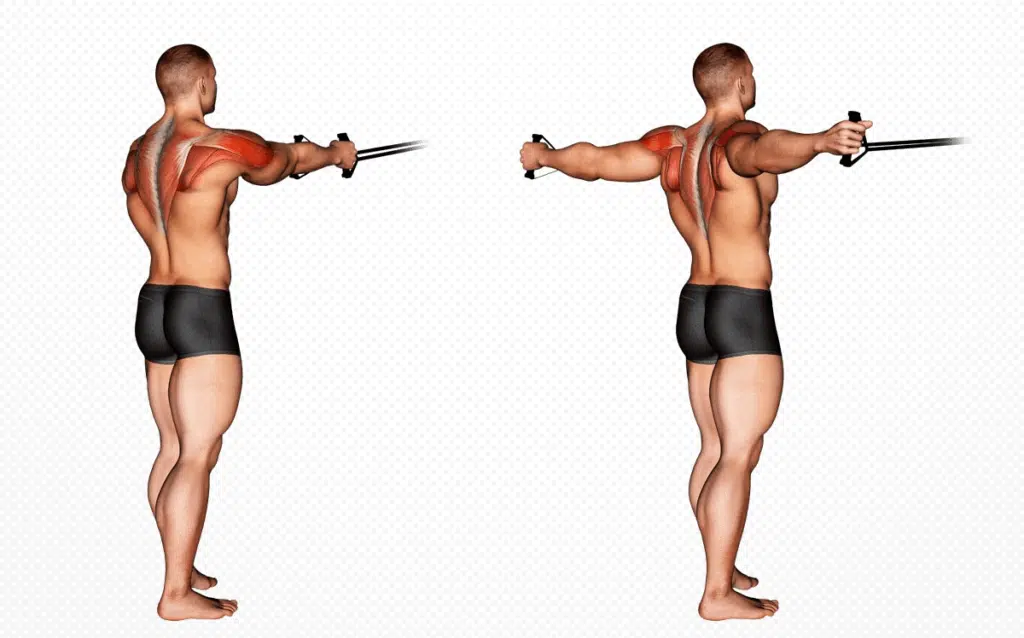
TRX Rear Delt Rows are a suspension training exercise that targets the rear delts, traps, and rhomboids while also engaging the core and stabilising muscles. Using your body weight and adjustable angles, this exercise allows you to control resistance, making it suitable for all fitness levels. It’s particularly effective for improving posture, shoulder stability, and overall upper back strength.
How to perform it:
- Grab the TRX handles and lean back so your body forms a straight line from head to heels. The further back you lean, the harder the exercise.
- Extend your arms fully in front of you, palms facing each other.
- Pull your elbows out to the sides, leading with your hands, until your hands are in line with your shoulders. Squeeze your shoulder blades together at the top.
- Slowly return to the starting position, keeping tension in the straps and maintaining a straight body line throughout.
Pros:
- Adjustable resistance using body angle, suitable for beginners and advanced users.
- Engages core and stabilising muscles along with rear delts.
- Requires minimal equipment and can be done almost anywhere.
Cons:
- Requires access to TRX or suspension straps.
- Incorrect body alignment can reduce effectiveness and risk of shoulder strain.
Tips:
- Keep your core tight to prevent sagging hips.
- Focus on controlled movements and scapular retraction.
- Gradually increase difficulty by leaning further back or adding pauses at the top.
Final takeaways
- Strengthening the rear delts is essential for maintaining good posture, improving shoulder stability, and preventing injuries—face pulls aren’t the only way.
- Incorporating a mix of machine, free-weight, band, and suspension exercises ensures balanced development and prevents plateaus.
- Proper form and controlled movements are critical for maximising gains and reducing the risk of injury.
Conclusion
Rear delts often get overlooked, but building them is key to strong shoulders, a healthy upper back, and better posture. These eight face pull alternatives give you a variety of options, whether you’re at the gym, working out at home, or travelling. Start by choosing 2–3 exercises that suit your equipment and fitness level, and gradually increase resistance or reps as you get stronger.
More to Read
I tested the 6 best Lat pulldown alternatives for back workouts
I used Zing Coach AI for 45 days—here’s my honest review
6 best Deadlift alternatives for strength and muscle growth (2025)

